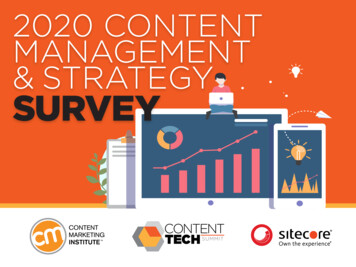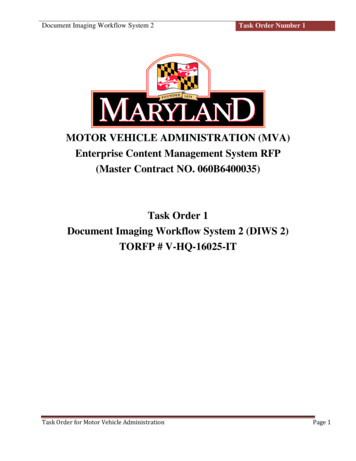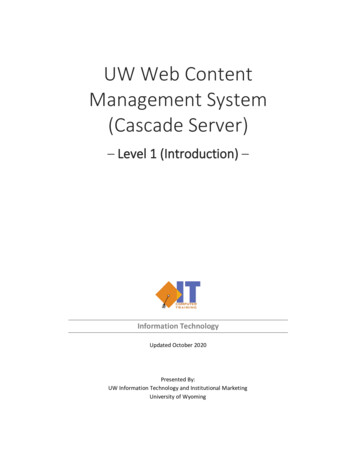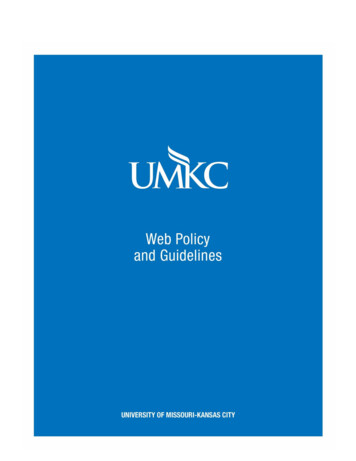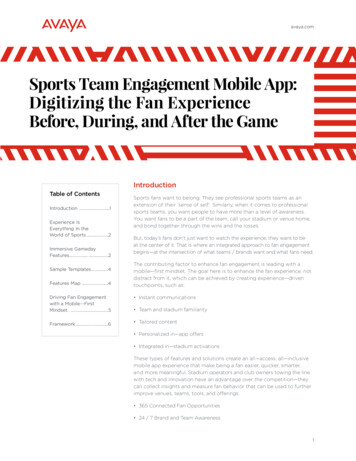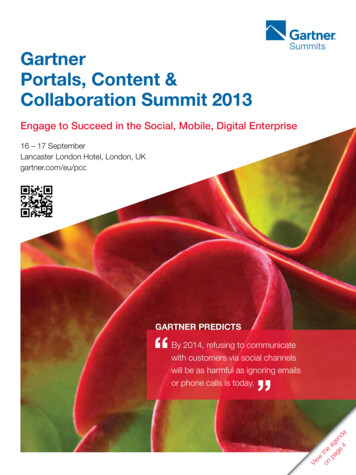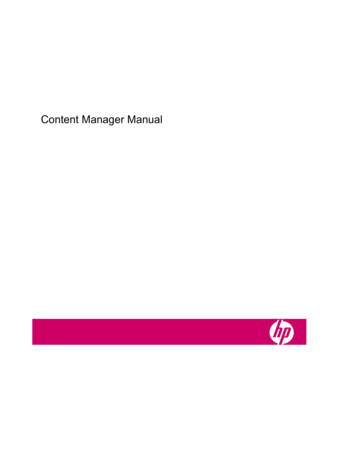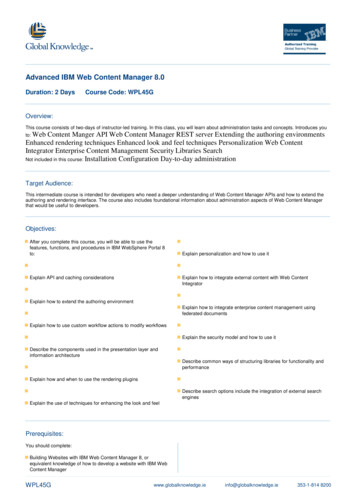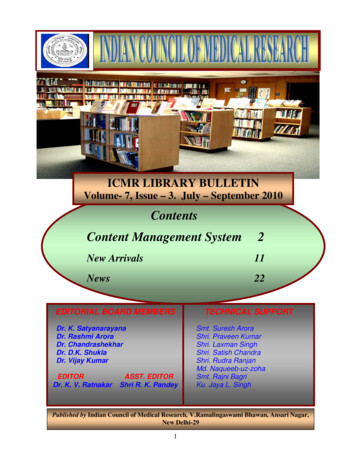
Transcription
ICMR LIBRARY BULLETINVolume- 7, Issue – 3. July – September 2010ContentsContent Management System2New Arrivals11News22EDITORIAL BOARD MEMBERSDr. K. SatyanarayanaDr. Rashmi AroraDr. ChandrashekharDr. D.K. ShuklaDr. Vijay KumarEDITORDr. K. V. RatnakarASST. EDITORShri R. K. PandeyTECHNICAL SUPPORTSmt. Suresh AroraShri. Praveen KumarShri. Laxman SinghShri. Satish ChandraShri. Rudra RanjanMd. Naqueeb-uz-zohaSmt. Rajni BagriKu. Jaya L. SinghPublished by Indian Council of Medical Research, V.Ramalingaswami Bhawan, Ansari Nagar,New Delhi-291
Content Management nalization and standardization ofcontent, and so on. A CMS is asoftware application that facilitatesthese tasks without the need forknowledge of HTML, CSS, or anyother web programming language.The two factors must be consideredbefore an organization decides toinvest in a CMS. First, anorganization's size and geographicdispersion must be consideredespecially if an organization is spreadout over several countries. For theseorganizations, the transition to CMS ismore difficult. Secondly, the diversityof the electronic data forms usedwithin an organization must beconsidered. If an organization usestext documents, graphics, video,audio, and diagrams to conveyinformation, the content will be moredifficult to manage. The features of aCMS system vary, but most includeWeb-basedpublishing,formatmanagement, revision control, andindexing, search, and retrieval.Information on the web is growingtremendously, and searching on theInternet today can be compared todragging a net across the surface ofthe ocean. Content is in essence, anytype or ‘unit’ of digital information. Itcan be text, images, graphics, video,sound, documents, records etc. or inother words anything that is likely tobe managed in an electronic format.The Internet’s explosion created anew set of problems for siteadministrators.Producingandmanaging content was becomingincreasingly difficult. A system wasneeded to manage, create, anddistribute various forms of content.TheContentManagementiseffectively the management of thecontent, by combining rules, processand/ or workflows in such a way thatits electronic storage is deemed to be‘managed’ rather than ‘unmanaged’.The new domain in its own right, as ithas employed the technologies andstrategiesofdigitalcontentmanagement to address businessprocess issues, such as records andContent ManagementtechnologiesincludeContentManagement Systems (CMS), Blogs,Wikis, and RSS etc. There are manyContent Management Software’sused like Joomla, Drupal, Bitweaver,Mambo, Pligg, Plone, Post Nuke,Tweak, zope etc.Application that enables users tomanage content in an orderly fashion,Content can include a variety of filetypes such as text, images, andmedia, which a CMS helps to create,edit, store and publish. The seen thatis more flexible and easier than thetraditionaltools.Thenew2
Content Management System (CMS)both can maintain the site to theirdesired control, even though bothhave different levels of technicalknowledge. After the arrival of Web2.0 technologies, many tools arethere in the seen, which are moreflexible and easier than the traditionaltools. It is capable to create apowerful portal website in a matter ofminutes and it has wide supportingcommunity. CMS consists of acontent management applicationwhich enables the management andmodification of content withoutadvanced webmaster knowledge, anda content delivery application, thatuses new information to update thewebsite. The CMA element allows thecontent manager or author, who maynot know HTML, to manage thecreation, modification, and removal ofcontent from a Web site withoutneedingtheexpertiseofaWebmaster. The CDA element usesand compiles that information toupdate the Web site.CMS means a tool for managingcontent, usually on a web site, thatseparates the design, interactivity,and content from one another tomake it easier for content authors toprovide content. CMS is a computerapplication used to create, edit,manage, search and publish variouskinds of digital media and electronictext. In simple terms, contentmanagement can be defined as aprocess of creating, collecting,organizing,categorizingandstructuring information resources ofany type or format so that they can besaved, retrieved, published, updatedand re-purposed in any waydesirable. A CMS is responsible forthe collection, management, andpublishing of chunks of informationknown as content components. Thebenefit of using a CMS, especially forwebsite creation, is that it does notrequire an extensive knowledge ofcoding. The CMS provides a bridgebetween the seasoned coder and theweekend blogger; in the sense that,CMS Subsystems:A CMS is composed of various subsystems that interact with these:i. Collection:Subsystem which handlesthecreationand/oracquisitionofinformation. It must provide supportfor the processes of content creation,workflows, syndication and integrationof external sources. In addition, itmust provide support to conversionprocesses between different formatsas well as for the incorporation ofcontents from different sources withinspecific structures.ii. Management:Subsystem in charge of themanagementandcontrolofinformation repositories, user groups,and support processes for othersubsystems. It handles the definingand controlling of information flows3
used by other subsystems, as well asthe definition of parameters for thefunctioning of the system.iii. Publishing:Subsystem in charge of finalproduction of publications and digitalinformation products in an automaticor semiautomatic manner. It makesuse of a model based on templatesand must provide personalizationoptions for users as well as thepossibility of producing for a variety ofplatforms and/or customers.Types of Content Management System:These terms describe the deploymentpattern for the CMS in terms of whenpresentation templates are applied torender web pages from structuredcontent. There are some major typesofCMS:Enterprisecontentmanagement systems, Web contentmanagement systems, Mobile contentmanagement system, ComponentcontentmanagementsystemDocument management system andLearning management system, etc.i. Enterprise content management systems (ECM):An enterprise content management(ECM) system is concerned withcontent, documents, details, andrecords related to the organizationalprocesses of an enterprise. nformation content, with all itsdiversity of format and location.ii. Web content management systems (WCM):A web content management (WCM)system is a CMS designed to simplifythe publication of web content to websites and mobile devices, inparticular, allowing content creators tosubmit content without requiringtechnical knowledge of HTML or theuploading of files.iii. Mobile content management system (MCMS):capable of multi-channel contentdelivery. Mobile content delivery hasunique, specific constraints includingwidely variable device capacities,small screen size, limited wirelessbandwidth, small storage capacity,and comparatively weak deviceprocessors.It is a type of (CMS) capable ofstoring and delivering content andservices to mobile devices, such asmobile phones, smart phones. Mobilecontent management systems maybe discrete systems, or may exist asfeatures, modules or add-ons oflarger content management systems4
iv. Component content management system (CCMS):It is a (CMS) that manages content ata granular level (component) ratherthan at the document level. Eachcomponent represents a single topic,concept or asset (e.g., image, table,product description). Componentscan be as large as a chapter or assmall as a definition or even a word.Components in multiple contentassemblies (content types) can beviewed as components or astraditionaldocuments.Eachcomponent is only stored one time inthe content management system,providing a single, trusted source ofcontent.Componentcontentmanagement (CCM) is typically usedfor multi-channel customer-facingcontent (marketing, usage, learning,support).v. Learning management system (LMS):Some LMSs are Web-based tofacilitate access to learning contentand administration. LMSs are used byregulated industries (e.g. financialservicesandbiopharma)forcompliance training. It is also used byeducational institutions to enhanceand support classroom teaching andoffering courses to a larger populationof learners across the globe.It is a software application for theadministration,documentation,tracking, and reporting of trainingprograms, classroom and onlineevents, e-learning programs, andtraining content. LMSs range fromsystems for managing training andeducational records, to software fordistributing courses over the Internetwith features for online collaboration.vi. Document management system (DMS):document imaging workflow systemsand record management systems.Severalwebbasedcontentmanagement systems exist both inthe Open Source and commercialdomains. However, this is one areawhere (OSS) has gained dominanceover proprietary counterparts.It is a computer system (or set ofcomputer programs) used to trackand store electronic documentsand/or images of paper documents.The term has some overlap with theconcepts of (CMS). It is often viewedas a component of enterprise contentmanagement (ECM) systems andrelated to digital asset management,5
Work chart of CMS:Content Management System (CMS)allows designers to focus on designby building templates. Subjectexperts build content in a separateenvironment. The server takes thecontent, inserts it into the correcttemplate and sends it all, neatlywrapped up, to end users. But that’sjust the technology side of CMsystems. CM’s other aspect is theway it addresses your workflow.Sure, it’s great to separate thedesign from the content, but CMwants to streamline how yourdesigns get approved and onto theserver.Create a design in whatevertool/environment you’re comfortablewith. Once it’s tested and ready to go,you pass it to your manager or editoror boss or whoever okays yourdesign. If it’s approved, it’s sent on tothe server. If not, you get notes and itis sent back to you, all within the CMenvironment: no email, no voice mail,no printouts of your design with redink and yellow sticky notes all over it.The same process happens on thecontent side. The end result is thateven though it’s easier for contentand design to publish, there are stillstrict controls as to what makes it tothe live server.Content Management Tools:facilitate reuse and enable flexiblepresentation options. Administrationis typically done through browserbased interfaces, but some systemsrequire the use of a fat client. UnlikeMost systems use a database to storecontent, metadata, and artifacts thatmight be needed by the system.Content is frequently, but notuniversally, stored as XML, to6
Web-site builders like MicrosoftFrontPage or Adobe Dream weaver,a WCMS allows non technical usersto make changes to an existingwebsite with little or no training. AWCMStypicallyrequiresanexperienced coder to set up and addfeatures, but is primarily a Web-sitemaintenance tool for non-technicaladministrators. Content managementtools allow anyone to edit their ownwebsite. Do not need to know HTMLor any other web language. ThisContent management, tools are away for a privileged user to makeupdates or additions to a web pagewithout the need for extensivetechnical knowledge. This allows acompany to easily modify its site atany time through a simple webinterface. Content management toolsallow companies to take control oftheir Web pages by managing thecontent as distinct from the design.The days of writing HTML for largeWeb sites may be numbered ascontent management tools take thefloor. Many organizations build thecontent management tools to meetthe specific needs, but in the last fewyears, several organizations havecome out with some good contentmanagementsoftware,someexamples of these are given here.http://www.daisycms.org:Daisy is a Java/XML open-sourcebased on the Apache Cocoon contentmanagement framework. Daisy is inuse at major corporations for intranetknowledgebases,projectdocumentation, and management ofcontent-rich websites.http://www.dspace.org:It is a groundbreaking digitalinstitutional repository that captures,stores, indexes, preserves, andredistributes.Itmanagesanddistributes digital items, made up ofdigital files and allows for thecreation, indexing, and searching ofassociated metadata to locate andretrieve the items.http://e107.orge107 is an open source Contentmanagement System (CMS) thatallows for the quick creation andmanagementofwebsitesorcommunity portals. It can be used for:websites or for local intranet pages, itcurrently has support for severallanguages available as additionaldownloads.http://www.fedora.info/:Fedora is an acronym for FlexibleArchitecture. Among these are digitalExtensible Digital Object Repositoryassetmanagement,institutional7
repositories, digital archives, contentmanagementsystems,scholarlypublishing enterprises, and digitallibraries.http://www.opencms .org/:Open Content Management System(CMS) is an open source CMS writtenin Java. Open CMS requires a JSPServlet container such as ApacheTomcat. It is a CMS application with abrowser-based work environment,assetmanagement,usermanagement, workflow management,aWYSIWYGeditor,internationalization support, contentversioning, and more features.http://phpcms.de/index.en.html:Php CMS is an open source CMSLike many content managementwritten using PHP. Its creatorssystems, php CMS intends to simplifydescribe php CMS as a highly flexiblea lot of tasks for the maintenance offlat file, no SQL, Web CMS withcomplex web sites.complete content/ logic separation.http://www.phpwcms.de:Php WCMS is an open sourceWCMS. It works on any web serverplatform that supports PHP with.MySQL, having been successfullytested on Windows XP and 2000,Mac OS X, and Linux.http://www.tikiwiki.org:TikiWiki CMS/Groupware, originallyand more commonly known asTikiWiki, is an open source (LGPL)CMS/GeospatialContentManagement System (GeoCMS) /Groupware web application enablingwebsites and portals on the internetand on intranets and extranets.http://www.webgui.org/:Web GUI is an open source ContentManagement System written in Perland released under the GNU GeneralPublic License. The system permitsnon-technically minded users toarrange content in pages and layouts,containing ‘Assets’ (applets) whichpermit website visitors to view andinteract with various types of datafrom basic Articles to full-blown CMSand custom applications.8
Conclusionwill be responsible to present libraryto the global community throughWWW. But gradually, it becamedifficult to maintain and update thewebsites because of their verydynamic nature and a variety of fileformats.ContentManagementSystems (CMS) evolved as analternative to such web-authoringtools. These procedures can bemanual or computer-based. It enableseven non-technical users to efficientlybuild a website, streamline the webpublishing procedures and quicklydeploy them, creating a content- richwebsite.Informationanddocumentationservices available on the Internetthrough web servers are growing inan exponential manner. In recenttimes,thefieldofcontentmanagement system has seenparticularly strong growth in opensource solutions, perhaps in directresponse to the very high prices thatcommercial content managementsystem have historically demanded. .This activity will give the staff anindication of what works and whatdoes not, what is interesting to theonline visitor and what is not pleasantto use. The library authority alsoneeds to be identifying the skilledmanpower and form a Web team whoReferences4.Wikipedia.Webcontentmanagement system. Available athttp://en.wikipedia.org/wiki/Web content mana g e m e n t s ys t e m.1.Kaushal, K.Giri Kirti, R.Nirgude, “Open Source is . Content management.Available at http://www.contentmanager.eu.com/2.Umesha, Naik. D, Shivalingaiah,“Open Source Software for ContentManagement System CALIBER 2009,p225-239.6.Best Open Source ContentManagementSystems:Chooseamong the most popular est t managemen t system.9
9. Content Management Tools.Available at http://web d e s i g n. a bo u t. c o m / o d / com tentmanagement/a /aa031300c. htm7.ContentManagementAvailable at http:// www.contentmanager. eu.com/cms. Htm.8.ContentManagementAvailable at http:// e n. w i k i p e d i a.org/wiki/Content management system.10. James, Ellis,” CMS and the singleweb designer. Graphic Design, ProjectManagement and Workflow , 2002.10
New ArrivalsContents363.7Environmental Problem12519Statistical Mathematics13571.4Biophysics14572.8Biochemical Genetics15576.5Genetics18614Incidence & Prevention of Disease19615.5Therapeutics20616.01Medical Microbiology2111
363.7ENVIRONMENTAL PROBLEMEncyclopedia of global warming and Climate Change /edited by S. George Philander.– California: Sage, 2008. 405p. ISBN: 9781412958783.363.738 74 P085493Abstract:This book include paleoclimatology i.e weather, climate and current debate about globalwarming. It include geographers, political scientists, chemists, anthropologists, medicalpractitioners, development experts & sociologists. The selection of articles are categories asatmospheric sciences, climate, climate change effects, climate and society, climatefeedbacks, climate models, institutions studying climate change, oceanography,paleoclimates, programs and convections & people studying climate change. It covers avast range of topics affecting global warming and global warming issues, concepts,theories, examples, problems and policies together in one place, with the goal people andtheir planet. It provides opportunity to reader to get information on the status of globalwarming its causes and effects by country.Keywords: Global warming- Encyclopedias; Climate change- Encyclopedias.12
519STATISTICAL MATHEMATICSRobust Methods in Biostatistics/ Stephane heritier [et al] . — UK:Wiley, 2009.268p. ISBN: 9780470027264.519.5 HER P95447Abstract:This book is intended to fill the existing gap and present robust techniques in a consistentand understandable manner to all researchers in the health sciences and related fieldsinterested in robust methods. The book in bio medical research used to motivate robustnessissues, explain the central ideas and concepts and illustrate similarities and differences withthe classical approach. It provides valuable feedback in academia. This book includes:biostatisticians who wish to discover robust statistics, update their knowledge with morerecent developments, applied researchers is medical or health sciences.Keywords: Biometry - Statistical methods.13
571.4BIOPHYSICSHandbook of Biological effects of Electromagnetic fields: bioengineering andbiophysical aspects of electromagnetic fields/ edited by Frank S. Barnes, BenGreenebaum .—London: Taylor & Francis, 2007. 430p. ISBN: 9780849395390.571.4 BAR P75463Abstract:This revised and updated edition of handbook of Biological effects of electromagneticfields has expanded coverage that includes more material on diagnostic and therapeuticapplications. As a handbook and not an encyclopedia this work does not intend to cover allaspects of bioelcetromagnetics. The increased amount of material has led to; thepublication of the handbook as two separate. Research in bioelectromagnetics stems fromthree sources, all of which are important and various chapters treat both basic physicalscience and engineering aspects and the biological and medical aspects of these.Keywords: Bioengineering; Biophysics.14
572.8BIOCHEMICAL GENETICSRussel, Peter J.iGenetics A Molecular Approach/ Russell, Peter j. -- 3rd ed.—New York:Benjamin Cummings, 2010. 828p. ISBN: 9780321569769.572.8 RUS P105454Abstract:The book covers all major areas of genetics, balancing classical and molecular aspects togive students and integrated view of generic principles. Gene therapy, gene mapping,genetic disorders, genetic screening, genetic engineering and the human genome, directlyimpact human lives. This book provides concepts of human genetics with numerousexamples; students are attracted by a natural curiosity to learn about themselves and ourspecies.Keywords: Molecular Genetics15
Gibson, Greg.A Primer of Genome Science / Greg Gibson, Spencer V. Muse. — 3rd ed. — USA:Sinauer Associates, 2009. 370p. ISBN: 9780878932368.572.86 GIB P95443Abstract:This book is an introduction to genome science intended for UG or graduate students whoare new to the field. Computational biology and statistical analysis play a central role ingenome research, and to capture this trend towards a merger of molecular and theoreticalbiology. It also include some exiciting new developments in the field of metabolomics(also known as metabonomics) and system biology. It provides the basis of bioinformaticsand experimental methods in one text to encourage students to develop a familiarity withgenomics that will be useful in pursue careers in science, law, journalism and marketing.Key Words: Genomics; Computational Biology- Methods.16
Handbook of Genome Research/edited by Christoph W. Sensen.— Weinheim:Wiley-VCH, 2005. 295p. ISBN: 9783527313488.572.86 SEN P5.1 5497Abstract:Handbook of genome research enables the establishment of the complete geneticinformation of organisms. The organisms selected for genome research were mostly thosewhich are already important in scientific analysis and thus can be regarded as modelorganisms. An introduction to the ever expanding technology of the subject is a major partof this book, which includes detailed description of the technology used to characterizegenomic organization, gene expansion, patterns, protein complements and the pasttranslational modification of proteins.Keywords: Molecular Genetics; Genome- Research.17
576.5GENETICSBazzett, Terence J.An Introduction to Behaviour Genetics / Terence J. Bazzett. – Massachusetts:Sinauer Associates, 2008. 476p. ISBN: 9780878930494.576.5 BAZ P85453Abstract:An introduction of behavior genetics proved to be highly challenging because theinteresting of scientific disciplines is so complex. Even with the assumption that studentsentering the course will have source background in the basic concepts of biology andchemistry, the range of general information also allows instructors to select and elaborateupon the topics they feel are most essential for meeting the learning objectives of theirindividual course? After reading this text, some readers are inspired to pursue a moreadvanced education in the field of behavior genetics.Keywords: Behavior genetics; Genetics.18
614INCIDENCE & PREVENTION OF DISEASEMagnus, ManyaEssential Readings in Infectious Disease Epidemiology/ Manya Magnus.—Massachusetts: Jones & Bartlett, 2009. 289p ISBN: 97807637385.614.5 MAG P95466Abstract:This book provides skills for the development of studies their implementation analysis,interpretation and dissemination. It also provides a literature review to understanding andsharing their public health implications. It provides all about epidemiology concepts,thought, Investigating HIV/AIDS, food borne disease and analytic methods, differentapproaches to examining bias in infectious disease epidemiology. The format of this text isto provide us with focused readings; guiding questions and exercises based upon thereading the thinking process will give us practice in critical evaluation.Key Words: Communicable Diseases- Epidemiology; Epidemiology19
615.5THERAPEUTICSCCRASResearch Study Profile of Rasamanikya /CCRAS. — New Delhi: CCRAS,2009.212p.615.53 P9C-2727Abstract:It provides metallic preparations in Ayurveda a Yogavahi having catalytic action. Itprovides usage of metals and minerals as medicines, a novel approach of Ayurveda.Ayurvedic materia medica is one of the largest among the traditional helath sciences. TheCCRAS has prepared some of the herbo-metal, herbo-mineral classical preparationsfollowing into classical methods and screened for their safety/ toxicity studies at differentinstitutes as per the standards guidelines, essential to ensure the safety/ efficacy,standardization, pharmacokinetic profile of these herbo-mineral medicines before clinicaltrails.Keywords: Rasamanikya; Ayurveda.20
616.01MEDICAL MICROBIOLOGYBauman, Robert W.Microbiology: with Diseases by body system / Robert W Bauman; contributions byElizabeth Machunis- Masuoka.—2nd ed. — New York: Pearson, 2009. 792p. ISBN:9780321513410616.01 BAU P95467Abstract:Microbiology with diseases by body system an updating it with latest research and dataavailable and incorporating the many terrific suggestions. In this text especially focus onthe metabolism, genetics and immunology in a way that beginning students can understandand at the same time present a through and accurate overview of microbiology. This bookalso to high light the many positive affects of microorganisms that causes disease. It coversbrief history of microbiology, beneficial effects of microbes, the clinical & applied side ofmicrobiology etc. It also provides website for microbiology.Keywords: Microbiology; Bacterial Infections- microbiology.21
NEWSGeneralNew Database of Alzheimer’s TrialsA new standardized database, containinginformation on 11 clinical trials and morethan 4000 patients with Alzheimer'sdisease (AD), has been released by theCoalition Against Major Diseases(CAMD)—aconsortiumofpharmaceutical companies, researchfoundations,andpatientadvocacy/voluntary health associations,with advisers from agencies such as thewww.c-path.org/CAMD.cfmUS Food and Drug Administration (FDA)and European Medicines Agency.According to CAMD, the aims of theshared database will be to accelerateresearch on all neurodegenerativediseases and to help in the developmentof new medications. Trial information onParkinson's, Huntington's, and other braindiseases will be added later.Free Audio BooksLibrophile is free and designed to makebrowsing for audio books and e-Books abreeze with its unique interface. There arepopular, free, bargain and paybookshelves as well as browse by genrehttp://www.librophile.comand search. One can download a singlechapter, the whole book, the podcast orplay chapters on the site using DK 2011International Conference on DigitalLibraries and Knowledge Organization(ICDK-2011) will be held at ManagementDevelopment Institute (MDI), Gurgaon,from February 14-16, 2011. ThisConference is Jointly Organized byManagement Development Institute, andIndian Association of Special Libraries &Information centers.Conference Sub- themes are Digital Libraries Development22
Tools and Techniques for Managing Digital RepositoriesDigital Resource Management StrategiesEvaluation of Digital LibrariesContent Development: Tools and TechniquesCultural Issues of Online ServicesTechnology Issues in Online ServicesStandards and Specifications for Digital ObjectsMetadata Standards, Interoperability and CrosswalksCase Studies of Digital Libraries and Institutional RepositoriesMultilingual Digital LibrariesDigital Preservation StrategiesWeb Retrieval Tools and StrategiesInformation Retrieval in Indian LanguagesUser Interface and Patron Interactions ToolsOpen Source Software Tools for Digital Library DevelopmentOpen Access Initiatives, Open Access RepositoriesOpen Access for Scholarly ContentsInformation Management Using Web 2.0/3.0 TechnologiesSocial Networking Tools for Information ServicesKnowledge Organization TechniquesKnowledge Representation ModelsEmergent Techniques for Search Algorithms and Context Sensitive IndexingSemantic Web Technologies for Knowledge Representation and ManagementOntologies and Approaches to Building Ontologieshttp://www.mdi.ac.in/ICDK/Home.htmlSixth International Conference on Webometrics, Informetrics andScientometrics (WIS) & Eleventh COLLNET MeetingSixth International Conference onWebometrics,InformetricsandScientometrics (WIS) will be held atUniversity of Mysore, Mysore fromOctober 19-22, 2010. Theme of thisconferenceareWebometrics,Informetrics and Scientometrics.Conference Sub- Themes are Emerging issues in Scientometrics / Informetrics /webometrics and historyScience Policy and collaboration Collaboration Studies for Science & Society Collaboration, Knowledge Management & Industrial Partnership Collaborative Bridge between Academic Research and Industry Techniques for Collaboration Studies23
Visualization Techniques in Collaboration Studies Quantitative analysis of S&T innovations Informetrics laws and distributions, mathematical models of communication orcollaboration Nature and growth of science and of collaboration in science and its relationwith technological output Evaluation indicators Collaboration in science and in technology from both quantitative andqualitative points of viewhttp://www.uni-mysore.ac.in/24
iii. Mobile content management system (MCMS): It is a type of (CMS) capable of storing and delivering content and services to mobile devices, such as mobile phones, smart phones. Mobile content management systems may be discrete systems, or may exist as features, modules or add-ons of larger content management systems capable of multi-channel .
